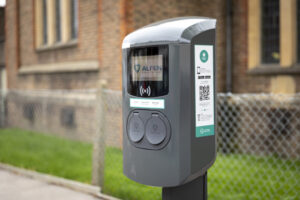The Fifth Carbon Budget is a chance to change our approach to transport
The government has a big problem with carbon from transport. Just as other sectors of the economy are beginning to reel their emissions in, those from domestic transport risk spiralling. Can the Fifth Carbon Budget put us on the road to sustainability?
The 2008 Climate Change Act requires the UK to reduce emissions by 80% from 1990 levels by 2050 via a series of carbon budgets. By the end of June, the government will legislate for the Fifth Carbon Budget focusing on the period 2028 to 2032. Transport is emerging as one of the major stumbling blocks in making the plan a reality. The government’s advisor on carbon emissions, the Committee on Climate Change, published its guidance for the Fifth Carbon Budget in November. It said emissions from transport need to start falling if we are to stay on track for the long-term goals. But emissions from transport are rising, spurred not least by massive government spending on roads.
Currently, about 20% of UK carbon emissions come from domestic transport. In 2013, surface transport emissions (rail and road) were estimated at 110 million tonnes of carbon a year. Of this, cars contributed 59% while a further 35% came from HGVs and vans. For their part, buses and trains contributed 4% and 2% respectively.
Between 1990 and 2013, transport emissions fell 4% because of more efficient engines and the switch from petrol to diesel. But this fall is mainly down to the period of the financial crash – emissions actually increased nearly 10% in the years before 2007, and were up again in 2014.
High transport emissions are the result of government policy. For example, fuel duty has been frozen for each of the last six years, making driving significantly cheaper in real terms. Vehicle Excise Duty is being ring-fenced for spending on roads, creating a permanent multi-billion pound shopping list of major projects. Lavish support is being given to local enterprise partnerships, whose transport expenditure is dominated by yet more tarmac. Meanwhile, the axing back local authorities funding has led to thousands of bus services being lost, and the new Cycling and Walking Investment Strategy is notably light on the investment element.
The Committee on Climate Change suggests transport emissions need to fall by 18% between 2010 and 2020, and by a further 30% from 2020 to 2030. Based on current policies, those look like stretching targets to put it mildly. The government is not expecting us to collectively travel less by car, so what is its plan? Put simply, it is relying on technology to sort everything out. To stay on track, the Climate Change Commission suggests engine efficiency will need to improve by a third and electric vehicles will need to reach 60% of sales by 2030 – to say nothing of the accompanying decarbonisation of electricity generation, demand for which could be 135% higher by 2050.
So, what should the government be doing? First, it should recognise electric cars alone will not get the job done. We need to invest in public transport rather than road building if we are to keep our towns and cities moving. This approach has allowed London, for example, to reduce per capita car use over the last 25 years. Focusing investment in networks of electric buses like that being trialled in Gothenburg would bring broader benefits to accessibility and air quality.
A generational shift away from car ownership should also be actively encouraged. In our larger cities, Uber, car clubs and journey planning apps mean trips one at a time rather than with the car as a default setting. Encouraging this approach to spread more broadly should be a priority.
More cycling and walking will lower emissions and improve health, too. The Cycling and Walking Investment Strategy says many of the right things, backing it with significant investment will enable it to deliver. There may also be low hanging fruit on HGVs, which represent only 5% of vehicles, but 25% of transport’s carbon emissions. Moving more freight to rail supported by ‘last mile’ road deliveries would reduce emissions while making city streets safer.
These and other initiatives will help get carbon emissions from transport under control – but do so much more besides. Rather than relying on greener cars, the government should seize the opportunities presented by the Fifth Carbon Budget to change the way we think about transport.
Photo by frankieleon 















